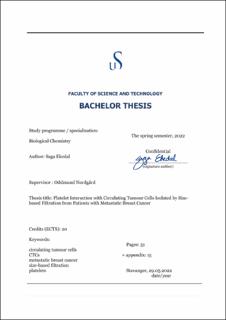| dc.contributor.advisor | Nordgård, Oddmund. | |
| dc.contributor.author | Ekedal, Saga. | |
| dc.date.accessioned | 2022-07-13T15:51:45Z | |
| dc.date.available | 2022-07-13T15:51:45Z | |
| dc.date.issued | 2022 | |
| dc.identifier | no.uis:inspera:108213961:23905113 | |
| dc.identifier.uri | https://hdl.handle.net/11250/3005144 | |
| dc.description.abstract | Metastasering är den främsta orsaken till cancer-associerade dödsfall. Cirkulerande cancerceller (CTCs) spelar en stor roll i den metastatiska processen och i sjukdomsförloppet. Det finns belägg som indikerar att trombocyt-interagering med CTCs kan hjälpa till i den metastatiska processen. Syftet med detta projekt var att använda storleksbaserad filtrering för att anrika CTCs från patienter med metastatisk bröstcancer och undersöka om de har trombocyter på ytan. Förhoppningen är att projektet kan bidra till ökad förståelse för denna typ av interaktion.
Cell-linjen ZR75-1 dyrkades på laboratoriet och dessa celler användes till validering av immunofluorescens färgning och anriknings experiment. Validering av anrikningsmetoden gjordes med VYCAPs filtreringsteknologi med både EDTA blod-provtagningsrör och CellSave rör. Mikroskipering användes för att kontrollera resultaten samt räkna cellerna. Observationerna tyder på att filtrering skadar i synnerhet celler som inte på förhand är fixerade. Fixerade celler tål filtreringen bättre och resultrerar i fler återfunna celler.
10 blodprov från 7 individer med metastatisk bröstcancer filtrerades och CTCs isolerades för att sedan analyseras i mikroskop. Vi återfann CTC i 9 av 10 patientprov. I 6 av de 9 proven med påvisade CTC fann vi även CTC med trombocyter. Antalet CTCs som interagerade med trombocyter varierade stort mellan patientproven, från interagering i 5.7% av CTCs upp till 70%. Av det totala antalet CTCs som återfanns i patientproven hade 25,5% minst en associerande trombocyt. Anrikningen resulterade även i fynd av CTC-kluster och i dessa förekom interaktion med trombocyter oftare.
Slutsatsen är att det är möjligt att påvisa trombocyter på CTCs isolerade med storleksbaserad filtrering från patienter med metastatisk bröstcancer. Andelen prov i detta projekt var däremot för lågt för att man ska kunna dra någon slutsats angående frekvensen av denna typ av interaktion. | |
| dc.description.abstract | Metastasis is the main reason for cancer associated deaths. Circulating tumour cells (CTCs) play a large role in the metastatic process and in the progression of cancer disease. There is evidence suggesting that platelet interaction with CTCs may facilitate in metastasis. The purpose of this project was to use size-based filtration to enrich CTCs from patients with metastatic breast cancer and analyse them for the presence of platelets on their surface. The hope is that the project will contribute to a better understanding of platelet-CTC interaction.
Cell line culturing of ZR75-1 cells was used for validation of immunofluorescent staining with various fluorophores and enrichment experiments. Validation of CTC enrichment was done with VYCAP’s size-based filtration technology using EDTA respectively CellSave blood. Microscopy was used to validate the results of the staining and to enumerate the cells. The observations show that filtration caused damage to the samples, particularly fresh cells. Fixed cells tolerated the filtration better and resulted in slightly higher recoveries in validation experiments.
CTCs were isolated from patients with metastatic breast cancer using size-based filtration. 10 blood samples from 7 individuals were filtrated to isolate CTCs and analyse them for the detection of platelets. There were detectable CTCs in 9 out of the 10 patient samples, with some of the enriched CTCs interacting with platelets. Out of 9 patient samples with detectable CTCs, 6 samples also contained CTCs with detectable platelets. The number of CTCs with platelets varied between individuals, with the percentage of CTCs with platelet interaction ranging from 5,7% to 70%. The percentage of CTCs that interacted with platelets out of the total number of CTCs was 25,5%. Apart from single CTCs, the enrichment also revealed CTC-clusters in some samples. All the CTC-clusters that were found had detectable platelets in them. These observations suggests that CTC-clusters are more often associated with platelets than single CTCs.
The conclusion drawn from the project is that it is possible to detect platelets in CTCs enriched from patients with metastatic breast cancer using size-based filtration. However, more patient samples are needed in order to give a reliable estimate of the frequency of interactions between CTCs and platelets. | |
| dc.language | eng | |
| dc.publisher | uis | |
| dc.title | Blodplate-interaksjon med sirkulerende kreftceller isolert med størrelsebasert filtrering fra pasienter med metastatisk brystkreft | |
| dc.type | Bachelor thesis | |
